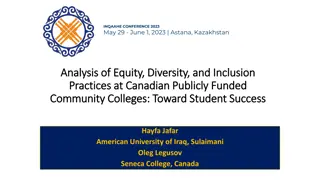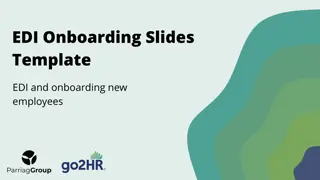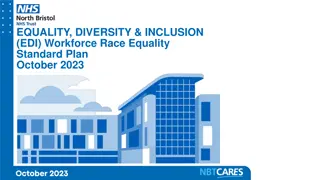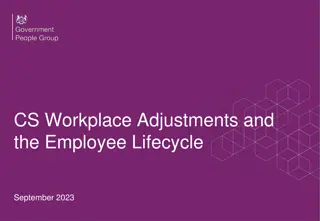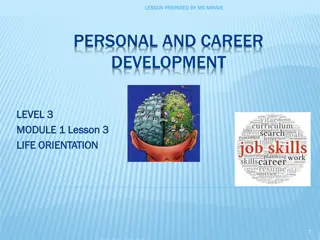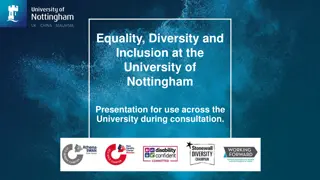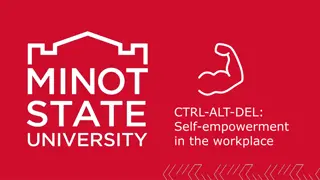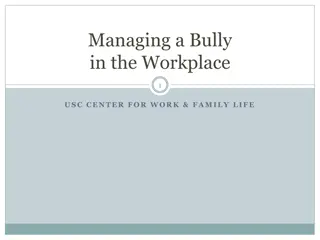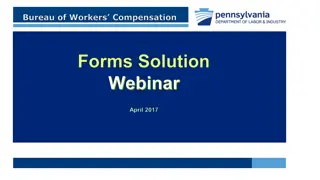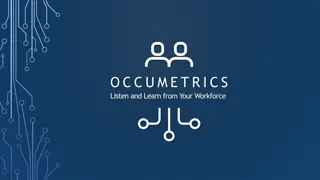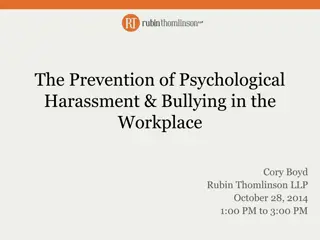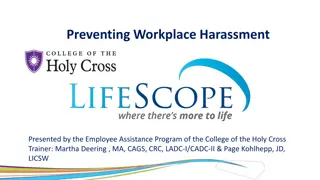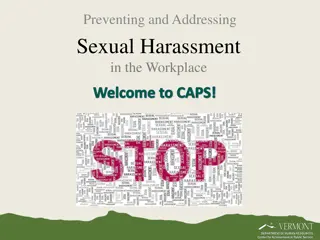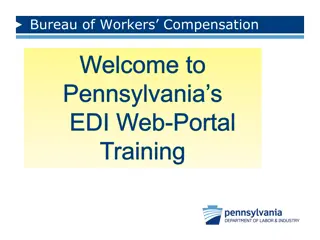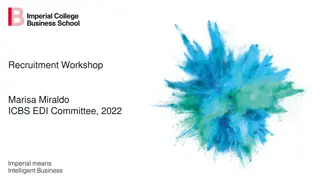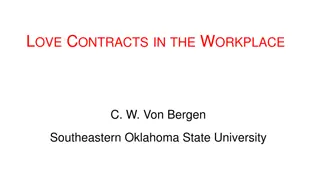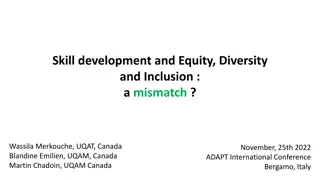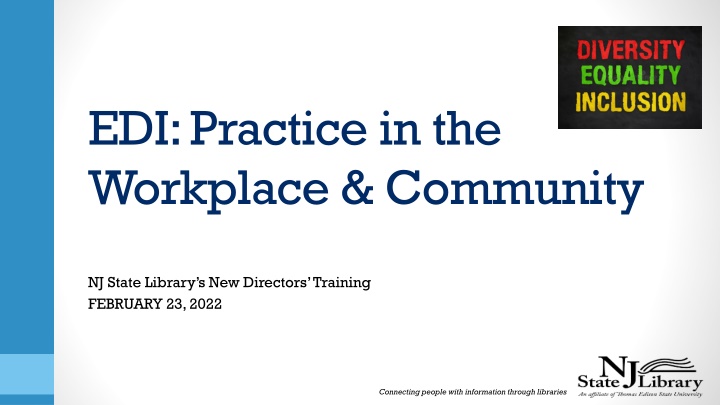
Workplace Diversity and Inclusion: Building Equitable Communities
Learn about the importance of equity in the workplace and community, including definitions, strategies for creating inclusive environments, and the significance of diversity plans. Explore how equity ensures fair opportunities for all individuals, regardless of their backgrounds or starting points.
Download Presentation

Please find below an Image/Link to download the presentation.
The content on the website is provided AS IS for your information and personal use only. It may not be sold, licensed, or shared on other websites without obtaining consent from the author. If you encounter any issues during the download, it is possible that the publisher has removed the file from their server.
You are allowed to download the files provided on this website for personal or commercial use, subject to the condition that they are used lawfully. All files are the property of their respective owners.
The content on the website is provided AS IS for your information and personal use only. It may not be sold, licensed, or shared on other websites without obtaining consent from the author.
E N D
Presentation Transcript
EDI: Practice in the Workplace & Community NJ State Library s New Directors Training FEBRUARY 23, 2022 Connecting people with information through libraries
Topics Covered ~ Definition ~ Educating yourself and your staff ~ Strategic Plan, creating mission statement, policies ~Diversity Plan and Community Asset Mapping ~Collection Development, diversity audit ~Additional resources Connecting people with information through libraries
Race and Hispanic Origin New Jersey https://www.census.gov/quickfacts/fact/table/NJ/PST045221 White alone, percent 71.9% kk Black or African American alone, percent(a) 15.1% American Indian and Alaska Native alone, percent(a) 0.6% Asian alone, percent(a) 10.0% Native Hawaiian and Other Pacific Islander alone, percent(a) 0.1% Two or More Races, percent 2.3% Hispanic or Latino, percent(b) 20.9% White alone, not Hispanic or Latino, percent 54.6% Connecting people with information through libraries
Equity, Diversity & Inclusion What Do We Mean By This?
Definitions Equity takes difference into account to ensure a fair process and, ultimately, a fair outcome. Equity recognizes that some groups were (and are) disadvantaged in accessing educational and employment opportunities and are, therefore, underrepresented or marginalized in many organizations and institutions. Equity, therefore, means increasing diversity by ameliorating conditions of disadvantaged groups. ("Equity, Diversity, Inclusion: An Interpretation of the Library Bill of Rights , American Library Association, July 5, 2017. http://www.ala.org/advocacy/intfreedom/librarybill/interpretati ons/EDI) Connecting people with information through libraries
Equity means that everyone gets what they need to succeed. But this ignores the huge differences in resources and treatment that already exist across racial groups in our country. For everyone to have a true opportunity to succeed, we need to acknowledge that we are all starting from different points on the track. When we focus on equity, our ultimate goal is justice. (Project READY: Reimagining Equity & Access for Diverse Youth, Module 12: Equity Versus Equality, Diversity versus Inclusion) Equity: The condition under which individuals are provided the resources they need to have access to the same opportunities, as the general population. Equity accounts for systematic inequalities, meaning the distribution of resources provides more for those who need it most. Conversely equality indicates uniformity where everything is evenly distributed among people. (Equity Definition. (n.d.). www.Naceweb.Org. https://www.naceweb.org/about- us/equity-definition/. )
Diversity can be defined as the sum of the ways that people are both alike and different. When we recognize, value, and embrace diversity, we are recognizing, valuing, and embracing the uniqueness of each individual. ("Equity, Diversity, Inclusion: An Interpretation of the Library Bill of Rights", American Library Association, July 5, 2017. http://www.ala.org/advocacy/intfreedom/librarybill/interp retations/EDI) Connecting people with information through libraries
Inclusion means an environment in which all individuals are treated fairly and respectfully; are valued for their distinctive skills, experiences, and perspectives; have equal access to resources and opportunities; and can contribute fully to the organization s success. ("Equity, Diversity, Inclusion: An Interpretation of the Library Bill of Rights", American Library Association, July 5, 2017. http://www.ala.org/advocacy/intfreedom/librarybill/interpretations/EDI) Other definitions can be found here: https://www.njstatelib.org/wp- content/uploads/2022/02/dei-glossary-of-terms-a11y.pdf - from California Community Colleges Glossary of Terms Inclusion is action. Outcome is belonging Becky Spratford, Actively Anti-Racist Service to Leisure Readers webinar Connecting people with information through libraries
Educating Yourself and Your Library Staff ~Start with yourself think about your identity, biases, and experiences ~ Self-Reflection - examining your personal identity and its role in the development and implementation of more equitable library services ~Recognize your implicit and unconscious biases ~Be aware of current terminology Hughes-Hassell, S., Rawson, C. H., & Hirsh, K. (2019).Project READY: Reimagining Equity & Access for Diverse Youth [online curriculum] The MSW@USC, the online Master of Social Work program at the University of Southern California. - Diversity Toolkit: A Guide to Discussing Identity, Power and Privilege, November 5, 2020 The Privilege Walk- adapted from Peggy McIntosh s concept of White Privilege https://www.eiu.edu/eiu1111/Privilege%20Walk%20Exercise- %20Transfer%20Leadership%20Institute-%20Week%204.pdf Connecting people with information through libraries
The University of North Carolina Chapel Hill (UNC-CH) Libraries did a 21 Day Racial Equity Challenge this past summer. The press release and link to the syllabus: https://library.unc.edu/2021/08/21-day-racial- equity-challenge-syllabus/ University of Maine s Folger Library also offered a week- long racial equity challenge in the summer of 2021: https://libguides.library.umaine.edu/racial-justice
Examples of EDI Statements in Libraries Wisconsin State Library s website has incorporated EDI on this webpage: https://dpi.wi.gov/pld/inclusive-services. The Inclusive Services Statement is their interpretation of Wisconsin library law. On a concrete level, inclusive services should be visibly incorporated into all library services. The concept that libraries are for everyone should be evident through every point of access or interaction with the library. A person s race, ethnicity, age, citizenship, literacy level, ability, family structure, income level, health status, gender identity, sexuality, style of dress, familiarity with public libraries - or any other dimension of identity -should neither negatively influence nor interfere with access to library services. Connecting people with information through libraries
Creating a Diversity Plan for Your Library Julie Edwards, Instructional Designer, Niche Academy, Diversity Plan for Your Library file:///C:/Users/srawlins/Desktop/Drafting%20a%20Diversity%20Plan%20for%20your %20Library%20Presented%20by%20Julie%20Edwards.pdf formal, intentional document that defines diversity and its importance for the library lists goals and outcomes that integrate diversity into everything the library does Survey your community, especially those who are underrepresented in your library, to find out what equity, inclusion, and diversity, means to them to help in creating your diversity plan. Their contributions to the planning allows them to have a sense of belonging in the library space.
Rochester Public Library, NY Rochester Public Library, NY has a commitment to equity, accessibility, inclusivity, and antiracism. They have a mission, vision and core values. Their strategic plan, action plan and logic model are posted on their website. Their mission: https://www.rplmn.org/about-us/about-rpl/vision- mission-planning They affirm that: WE CARE Welcoming Environment Committed to Inclusivity Access for all Respect intellectual freedom Exceptional library service Connecting people with information through libraries
Community Asset Mapping Community assets can be people, a physical place, like a recreation centers, or a community service like a cultural organization. Everyone in the community can be an asset. There are multiple formats for asset mapping. Use a format that best serves your needs. You can even mix formats together. Here are a few templates and examples that you can use: See page 38 of The Engaged Library: Chicago Stories of Community Building (Urban Libraries Council 2006 report) Verena Getehun on Asset Mapping https://youtu.be/PqRNChkbfE0 Connecting people with information through libraries
Community Asset Mapping https://ctb.ku.edu/en/table-of-contents/assessment/assessing- community-needs-and-resources/identify-community-assets/main - Community Tool Box, section on Assessing Community Needs Subramaniam, M., Braun, L.W., Asgarali-Hoffman, S.N., Jordan-Stovall, K. & Kodama, C. (2021). Library staff as public servants: A field guide for preparing to support communities in crisis. College Park, MD: University of Maryland. https://yxlab.ischool.umd.edu/wp-content/uploads/2021/02/Field- Guide-2021-Final.pdf Connecting people with information through libraries
Diversity Audit of Your Collection From Diversity to Inclusion: How to Audit Your Collection and Why, presented by Kymberlee Powe, Children and YA Consultant for the Connecticut State Library The examples and resources provided in this session will focus on youth collections; however, the methodology of performing a diversity audit, and the reasons to do so, are universal to all collections. https://www.youtube.com/watch?v=vzK0dL_QSC0 LLNJ s Actively Anti-Racist Library Service to Leisure Readers webinar, presented on Jan. 21, 2022 by Becky Spratford, a Readers Advisor in IL, and librarian, and Robin Bradford, a collection development librarian in Washington State. https://librarylinknj.org/calendar/actively-anti-racist-library-service-leisure- readers-0
Developing a Diverse Collection Just because titles are diverse, doesn t mean they are well written or should be added to your collection. Here s an example of a new series that the Social Justice Books website doesn t recommend. The Disempowering Impact of the Little People, BIG DREAMS Series - Social Justice Books By Paige Pagan and the Social Justice Books Team
Additional Resources Cooke, N. A. (2020, May 30). Anti-Racism Resources for all ages. [A project of the Augusta Baker Endowed Chair at the University of South Carolina]. https://padlet.com/nicolethelibrarian/nbasekqoazt336co Read, watch, listen and discuss with colleagues and community members any of the various books, articles, videos, or podcasts found on the padlet. National Equity Atlas:https://www.communitycommons.org/entities/cae5c59b- d8b7-4004-aaa6-b7a03851cbd2 - Interactive data tool that s a detailed report card on racial and economic equity. Includes demographic change, racial and economic inclusion, and the potential economic gains from racial equity for the largest 100 cities, largest 150 regions, all 50 states, and the United States as a whole. Government Alliance on Race & Equity. (n.d.).Advancing Racial Equity in Public Libraries: Case Studies from the Field. https://www.racialequityalliance.org/wp- content/uploads/2018/04/GARE_LibrariesReport_v8_DigitalScroll_WithHyperlinks. pdf P. 37 has Table called GETTING STARTED WITH RESULTS-DRIVEN PLANNING lists the action steps needed. Connecting people with information through libraries
Additional Resources Continued EDI Collaborative for NJ Libraries, created by the leadership of the NJSL, NJLA, LLNJ https://librarylinknj.org/EDI/EDI-framework-for-NJ-libraries https://librarylinknj.org/sites/default/files/pdfs/2022%20EDI%20Framewor k%20for%20NJ%20libraries.pdf Conscious Style Guide resource on inclusive terminology, regarding gender, sexuality, ethnicity, etc.
Thank you! Sharon Rawlins, Youth Services Specialist, NJ State Library, srawlins@njstatelib.org Connecting people with information through libraries

